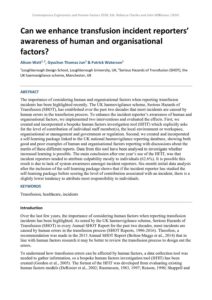| Document | Author Alison Watt, Gyuchan Thomas Jun & Patrick Waterson |
| Abstract The importance of considering human and organisational factors when reporting transfusion incidents has been highlighted recently. The UK haemovigilance scheme, Serious Hazards of Transfusion (SHOT), has established over the past two decades that most incidents are caused by human errors in the transfusion process. To enhance the incident reporter’s awareness of human and organisational factors, we implemented two interventions and evaluated the effects. First, we created and incorporated a bespoke human factors investigation tool (HFIT) which explicitly asks for the level of contribution of individual staff member(s), the local environment or workspace, organisational or management and government or regulation. Second, we created and incorporated a self-learning package linked to the UK national haemovigilance reporting database, showing both good and poor examples of human and organisational factors reporting with discussions about the merits of these different reports. Data from this tool have been analysed to investigate whether increased learning is possible. The main conclusion after one year’s use of the HFIT, was that incident reporters tended to attribute culpability mostly to individuals (62.6%). It is possible this result is due to lack of system awareness amongst incident reporters. Six-month initial data analysis after the inclusion of the self-learning package shows that if the incident reporter has studied the self-learning package before scoring the level of contribution associated with an incident, there is a slightly lower tendency to attribute most responsibility to individuals. |

